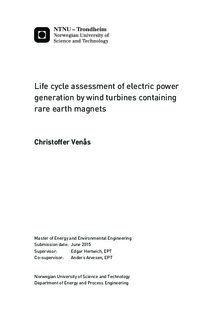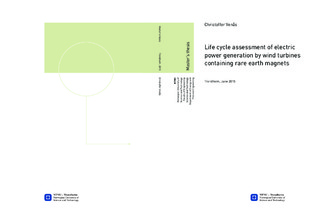| dc.description.abstract | Direct-drive permanent magnet generator (DD-PMG) wind turbines are becoming a larger part of the growing offshore wind turbine market. The strong permanent magnets used, the NdFeB magnets, contains neodymium metal. The neodymium metal is a rare earth element (REE), and there are large environmental concerns regarding the mining and processing of the REEs. The research within the field is scarce. Consequently, there is a lack of knowledge of the environmental consequences of a shift away from the conventional gear-based turbine technology. In this thesis, a life cycle assessment (LCA) of electricity power production from offshore DD-PMG turbines was performed. To my knowledge, there are no previous LCAs of the DD-PMG turbines, thus the thesis will provide the first steps to fill this gap of knowledge.
To be able to compare the conventional and the DD-PMG technology, an acknowledged, existing life cycle inventory (LCI) of an offshore wind farm, consisting of conventional wind turbines, was used (Arvesen et al. 2013). The inventory was modified to represent a wind farm with DD-PMG turbines. The scope of the assessment included a detailed inventory of the production of neodymium metal, which was important to accomplish an evaluation of how the use of REEs affected the environmental performance of wind power.
In the assessment, it was found that the DD-PMG had less impact than the conventional design in 12 of the 13 included environmental categories. The increased electricity power production for the DD-PMG turbine was one main driver for the reductions, together with reductions because of a more compact nacelle. The omission of the gearbox led to a lighter, more streamlined nacelle configuration that turned out to be important for the results. In addition, there was less copper mass in the DD-PM generator. This caused reductions in the impact, especially in the toxicity and freshwater eutrophication categories. In these categories, we saw the highest reductions, which were in the range of 13-24 % for the process-based LCA results.
Excluding the foundation, the NdFeB magnet mass share is 0,46% of the wind mill construction. Thus, it is a small part of the total wind farm system, but does have a considerate impact in many of the categories. It is dominant for the marine eutrophication category, leading to an impact increase of 58 % from the conventional to the DD-PMG design. The relative share of the total impact related to the neodymium magnet is in the range of 2-6% for 10 of the 13 considered categories. A closer analysis showed that the use of copper was more critical than the use of NdFeB magnet material to the impacts in the toxicity category group. This indicates shortcomings of the neodymium metal inventory, as one would assume that these impacts at least would be similar for the two materials. More data based on the empirical practice of neodymium metal production is a prerequisite to develop the environmental research within the field. The neodymium metal inventory does show robustness for more fossil energy-dependent categories, like climate change, where the use of NdFeB turns out to be more critical than copper.
A benefit of the DD-PMG turbines is claimed to be an increased reliability compared to the conventional technology, since critical gearbox failures are avoided. In a sensitivity analysis, it is shown that a decreased downtime, together with less maintenance activities from marine vessels, gives a potential of even higher reductions of the environmental impact.
The results from the thesis shows that the DD-PMG design is beneficial from an environmental point of view. The advantages of reduced weight in the nacelle and increased electricity production in the DD-PMG design outperforms the disadvantage of using NdFeB magnets.
For å kunne sammenligne vindkraft fra konvensjonelle og DDPMGturbiner, ble det brukt et eksisterende, anerkjent livsløpsinventar (LCI) av en offshore vindmøllepark med konvensjonelle turbiner (Arvesen et al. 2013). Inventaret ble modifisert slik at det fremstod som en vindmøllepark med DDPMGturbiner. Innenfor rammen av oppgaven var det også ønsket et detaljert inventar av sjeldne jordarter. Dette var viktig for å kunne vurdere hvordan bruken av REE påvirket miljøbelastningene knyttet til vindkraft. I analysen fant vi at DDPMGturbiner hadde mindre påvirkning enn konvensjonelle turbiner i 12 av de 13 undersøkte miljøkategoriene. Den økte elektrisitetsproduksjonen og en lettere og mer kompakt nacelle førte til disse reduksjonene. Det viste seg at en lettere nacelle, på grunn at man utelater girkassen i DDPMGdesignet, var viktig for resultatene. I tillegg var det mindre bruk av kobber i DDPMgeneratoren. Dette reduserte særlig miljøpåvirkningene i kategorier for toksisitet- og ferskvannseutrofiering. I disse kategoriene var reduksjonene størst, 1324%, for (de prosessbaserte) LCAresultatene.
NdFeBmagnetene utgjør kun 0,46% av vekten til vindmøllekonstruksjonen, om vi utelater fundamentmassen til konstruksjonen. Den har allikevel forholdsvis høy påvirkning på resultatene. Særlig for kategorien for marin eutrofiering, hvor fremstillingen av neodymium fører til en økning i miljøbelastningene på 58%. Andelen knyttet til NdFeBmagnetene er fra 26% av resultatene i 10 av 13 miljøkategorier. Nærmere undersøkelser viser at bruken av kobber er viktigere for resultatene enn NdFeB for miljøbelastinger i toksisitetkategorigruppa. Dette kan indikere at inventaret for neodymiummetallet ikke dekker de reelle miljøbelastningene, siden man i utgangspunktet skulle tro at belastningene i det minste var like for de to metallene. Større datatilgjengelighet basert på empirisk forskning er en forutsetning for framtidig utvikling av forskningen innen feltet. I andre kategorier, som påvirkes mer av bruken av fossil energi, ser vi imidlertid at inventaret er robust.
Mindre vedlikehold og færre driftsstans hevdes å være en fordel for DDPMGturbiner, siden man unngår de kritiske feilene på girkassa. Resultatene fra denne oppgaven viser at mindre nedetid for turbinene, samt mindre bruk av skipsfartøy til vedlikehold, gir et potensiale for enda høyere reduksjoner av de miljømessige påvirkningene.
Ved en total vurdering av miljøbelastningene, viser resultatene fra denne oppgaven at DDPMGdesignet er fordelaktig. I denne sammenhengen er ulempene ved å bruke NdFeBmagneter mindre enn fordelene av en lettere nacelle og økt elektrisitetsproduksjon. | |

